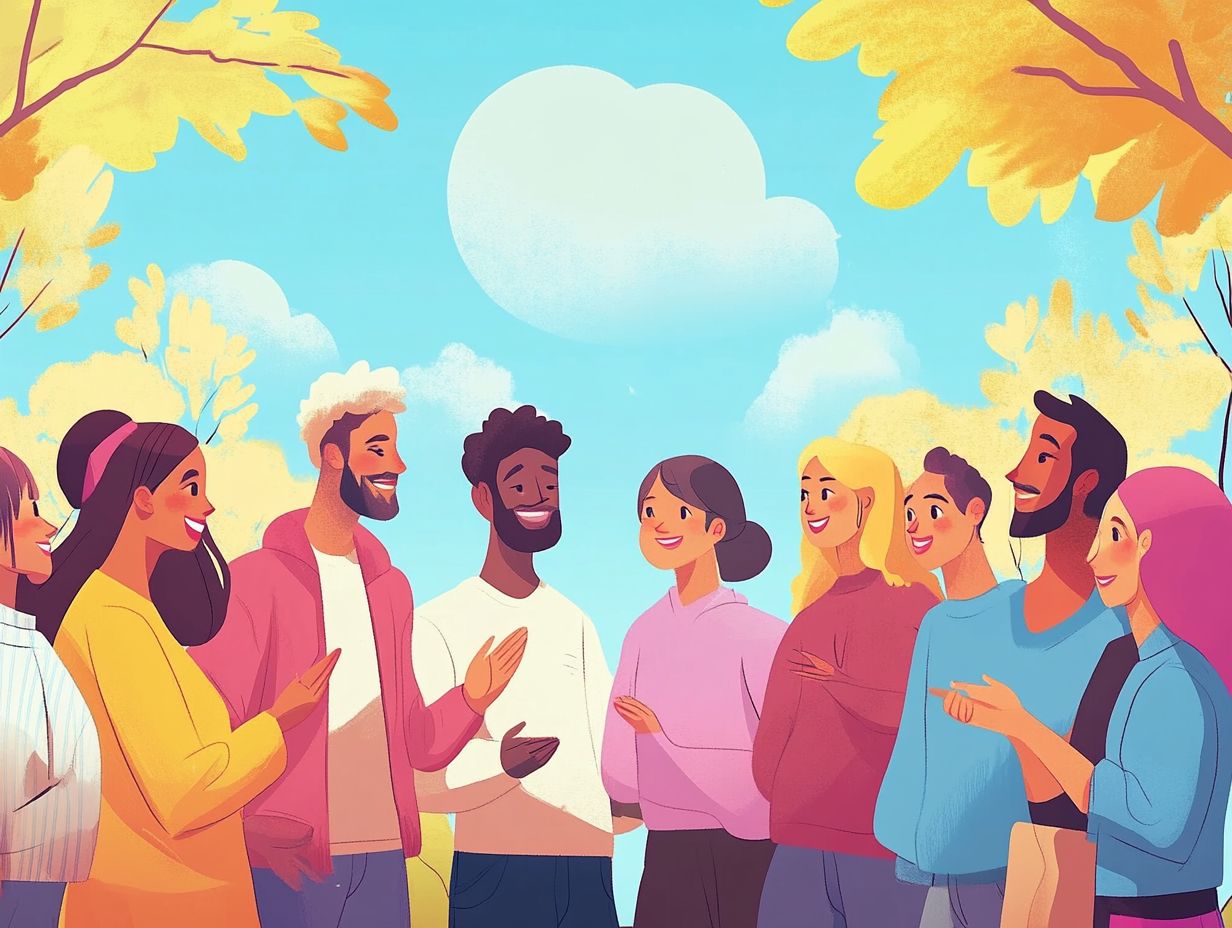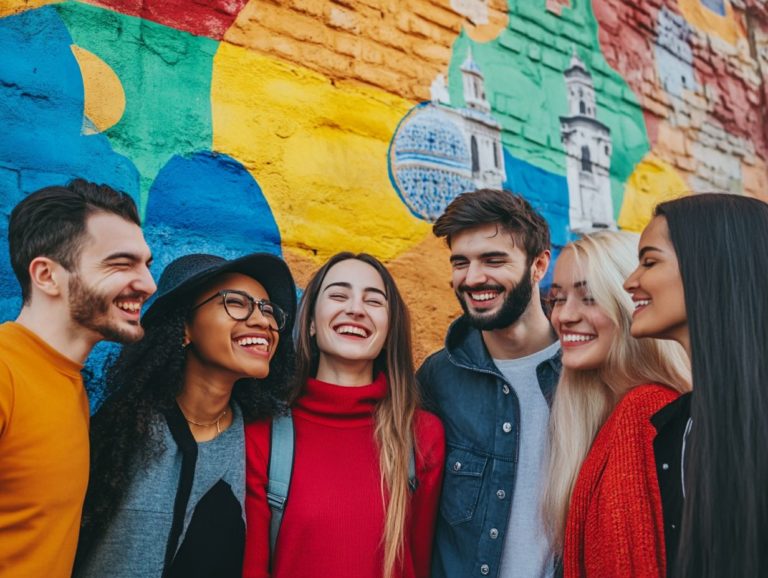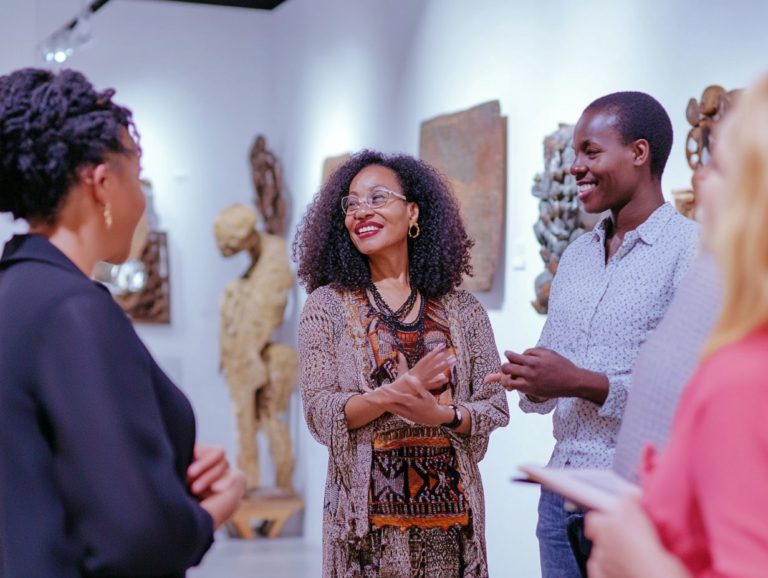10 Tips for Navigating Local Social Norms
Traveling to a new country can be an exhilarating adventure. However, it also brings unique challenges, especially regarding local customs and social norms.
Understanding the local culture, along with body language and communication styles, can greatly enhance your experience. This article presents ten essential tips designed to help you navigate diverse social landscapes, ensuring you engage respectfully and effectively with the communities you encounter.
Whether you re a seasoned traveler or embarking on your first journey, these tips will empower you to embrace new cultures with confidence and grace.
Contents
- Key Takeaways:
- 1. Understand the Cultural Context
- 2. Observe and Listen
- 3. Be Respectful and Polite
- 4. Dress Appropriately
- 5. Learn Basic Phrases in the Local Language
- 6. Be Aware of Gender Roles and Interactions
- 7. Be Mindful of Personal Space
- 8. Be Aware of Gestures and Body Language
- 9. Familiarize Yourself with Table Manners
- 10. Understand Social Hierarchies
- What Are Some Common Social Norms Around the World?
- Frequently Asked Questions
- 1. What are some general tips for navigating local social norms?
- 2. Should I research the local social norms before traveling?
- 3. Is it okay to ask questions about local social norms?
- 4. What should I do if I accidentally break a social norm?
- 5. Are there any specific social norms that I should be aware of in different countries?
- 6. How do social norms differ in urban and rural areas?
Key Takeaways:

- Respect and politeness go a long way in navigating local social norms.
- Observe and listen to understand the cultural context and avoid common mistakes.
- Be mindful of personal space, gestures, and table manners to show respect and appreciation for different cultures.
1. Understand the Cultural Context
Understanding the local culture is crucial for you as a traveler aiming to engage respectfully with diverse societies. It encompasses the different cultural rules, social expectations, and unique customs that shape how people interact across various regions of the world.
By immersing yourself in local traditions and practices, you can enrich your experiences and cultivate meaningful connections through cultural sensitivity. Take Japan, for example; here, politeness and special words used to show respect are paramount in communication.
Bowing is often the preferred greeting over handshakes, reflecting a deep-rooted respect for hierarchy. In contrast, when you find yourself in France, you ll notice that social encounters lean heavily on conversation etiquette and a genuine appreciation for the art of cooking, where grasping mealtime rituals is essential for blending into local dining culture.
Meanwhile, in Brazil, the vibrant expressions of community during festive gatherings showcase a dynamic approach to social interaction that cherishes warmth and participation. By being aware of these distinct cultural intricacies, you can navigate local dynamics with greater ease, leading to more impactful and respectful exchanges while savoring the authenticity of each destination.
2. Observe and Listen
Observing and listening are essential elements of effective communication, especially when you find yourself navigating unfamiliar cultural landscapes. These skills enable you to pick up on subtle non-verbal cues and body language that can reveal local customs and cultural expectations.
By refining your observational abilities, you can uncover the unwritten rules that dictate social interactions. For instance, the significance of eye contact may vary dramatically; in some cultures, it signifies attentiveness, while in others, it might be perceived as confrontational.
Take the time to appreciate these nuances: in many Asian cultures, a slight bow can convey deep respect, while in Western contexts, a firm handshake exudes confidence. Actively engaging with these diverse communication styles cultivates authentic connections and enhances your capacity to adapt and interact respectfully whether you re enjoying a casual chat at a local caf or navigating formal business meetings in multinational corporations.
3. Be Respectful and Polite
Being respectful and polite is fundamental to successful interactions in any culture. It showcases your understanding of local etiquette and a commitment to positive norms that honor the values of hospitality and gratitude found in societies around the globe.
From bowing in Japan to offering a handshake in the United States, traditional greetings serve as gateways to establishing trust and rapport. These gestures carry profound significance, reflecting the cultural nuances that shape social interactions.
As you explore these diverse landscapes, consider learning a few key phrases in the local language; this can significantly enhance your experience. By showing appreciation for local customs whether it s participating in communal meals or adhering to dress codes you not only convey respect but also open the door to meaningful interactions and deeper connections with the local people.
4. Dress Appropriately
Dressing well shows respect it’s your ticket to connecting with locals!
Your attire reflects local customs and community values. For example, in India, wearing traditional garments like sarees or kurtas shows respect during festivals.
In South Korea, formal attire is essential when visiting someone’s home, highlighting the importance of respect and hierarchy.
On the other hand, Australia embraces a laid-back approach. However, it’s still vital to dress appropriately for formal occasions.
5. Learn Basic Phrases in the Local Language
Learning simple phrases in the local language can elevate your travel experience.
It shows you’re willing to engage and respect local traditions. In Brazil, saying “obrigado” invites warmth and openness.
In China, saying “xie xie” can lead to deeper conversations and help bridge cultural gaps.
By learning these phrases, you can navigate more effectively and earn local admiration. This enriches your travel experience and fosters genuine connections.
6. Be Aware of Gender Roles and Interactions

Understanding gender roles is key when navigating cultural landscapes.
These dynamics can vary widely, affecting how people communicate. In Western cultures, interactions are often direct, while other societies may have more nuanced approaches.
Observing local customs and asking open-ended questions fosters respectful dialogues. Embracing curiosity helps build deeper connections and honors diverse perspectives.
7. Be Mindful of Personal Space
Personal space varies greatly across cultures and affects communication.
In Japan, people maintain a respectful distance, while in Latin America, close proximity is a sign of warmth.
To navigate these differences, be observant of body language and cues. Familiarizing yourself with local customs leads to respectful and effective communication.
8. Be Aware of Gestures and Body Language
Understanding gestures and body language is essential for effective communication across cultures. Non-verbal cues can convey messages that vary significantly from one culture to another. This can impact interactions and cultural etiquette.
Take Japan, for example. Here, bowing is a traditional greeting that signifies respect and humility. In contrast, many Western nations favor a firm handshake, which symbolizes confidence and equality. These differing interpretations can easily lead to misunderstandings if you re not aware of the cultural context.
To navigate these differences smoothly, it s wise to research local customs before you travel or engage with people from diverse backgrounds. By paying attention to your surroundings, observing others behaviors, and asking questions, you can ensure that gestures are interpreted correctly.
This approach fosters smoother communication and helps you build stronger interpersonal relationships.
9. Familiarize Yourself with Table Manners
Familiarizing yourself with table manners is essential for enjoying meals across different cultures. Dining etiquette can greatly influence your interactions and reflect the rich cultural practices surrounding shared food and hospitality.
Understanding these customs enhances your dining experience and helps build meaningful connections with others. For instance, in China, mastering the art of chopsticks is not just a practical skill; it s a gesture of respect. Avoid pointing them at others or sticking them upright in rice, as these actions can be deemed impolite.
In India, communal dining is a beautiful expression of togetherness, where shared dishes are served on a common platter. Remember to partake with your right hand and express gratitude for the hospitality offered.
Embrace these practices to navigate dining settings gracefully and impress those around you!
10. Understand Social Hierarchies
Understanding social hierarchies is crucial as you navigate interpersonal interactions (how people relate to each other) across various cultures. These structures can significantly shape community dynamics (how people interact in a community) and profoundly influence cultural practices.
Take Russia, for example. Here, social hierarchies are often rooted in historical class structures and current economic disparities. One’s status may stem from both wealth and education. In contrast, the United Arab Emirates presents a more intricate blend of dynamics, intertwining tribal affiliations with expatriate influences.
In this context, local customs emphasize respect for elders and those in authority. When engaging with individuals from these diverse backgrounds, recognizing and respecting these nuanced hierarchies becomes essential.
Simple gestures, like offering a polite greeting or acknowledging titles, can greatly enhance mutual respect and understanding.
What Are Some Common Social Norms Around the World?
Common social norms around the world present a fascinating tapestry of cultural differences and unique customs that influence daily interactions and community engagement. These norms shape everything from greetings to dining etiquette.
Take Italy, for example. There, personal greetings often include a warm embrace or a kiss on the cheek, reflecting the immense value placed on close personal relationships. In Brazil, you ll find a similar warmth, amplified with lively body language and exuberance, showcasing a zest for life that permeates social interactions.
Meanwhile, in Thailand, the custom of the wai a gesture involving a bow with hands pressed together embodies deep respect and acknowledges cultural hierarchy.
By recognizing and appreciating these variances, you cultivate deeper connections. This understanding allows you to navigate interactions with thoughtfulness and respect, enhancing your global social acumen.
How Can One Prepare for a Trip to a Different Culture?

Preparing for a trip to a different culture requires thorough research and understanding of local customs. Arm yourself with travel tips that enhance your cultural experience and cultivate openness to exploring the landscapes and unique traditions of your destination.
Familiarize yourself with local customs. This includes greeting styles, dining practices, and dress codes. Understanding these will help you foster genuine connections with locals and enrich your experience.
Engaging with community dynamics can elevate your journey. Participating in local events or volunteering opens doors to meaningful interactions that you won t find in a guidebook.
Learning some basics of the local language is beneficial. Even mastering a few key phrases shows respect and a genuine willingness to engage with the culture. Prioritizing cultural sensitivity enhances your journey and promotes mutual respect.
Navigating local social norms can be quite the adventure. Common pitfalls often arise from a lack of cultural sensitivity and misunderstandings about cultural expectations. To help avoid these issues, consider the top 10 tips for adapting to a new culture, which can lead to smoother interactions and greater comfort.
You might encounter awkward situations, like using gestures that don’t translate well or misinterpreting dining etiquette. For instance, in some cultures, flashing a thumbs-up might be offensive, while leaving a tip could be seen as an insult.
To avoid these missteps, make it a point to learn about local customs before you set foot at your destination. Observing those around you and asking locals about appropriate behavior can lead to respectful interactions and meaningful connections.
Don’t underestimate the power of expressing gratitude for the hospitality you receive; it can significantly enhance your travel experience and help you build rapport with those you meet along the way.
How Can One Show Respect and Appreciation for Different Cultures?
Respecting and appreciating other cultures is key. You can achieve this by recognizing cultural practices and using ways to show thanks that convey gratitude and understanding.
To truly connect with others, consider participating in local traditions. This might involve attending community celebrations or learning about traditional customs that hold significance for the people involved.
Making an effort to learn a few essential phrases in another language can greatly enhance communication and demonstrate your willingness to embrace cultural nuances. Thoughtful gestures, like offering small tokens of appreciation or asking questions about someone s heritage, can create an inviting atmosphere.
Ultimately, embracing cultural sensitivity deepens relationships and enriches your personal journey, fostering a sense of shared humanity.
How Can One Communicate Effectively in a Different Culture?
Effective communication in a different culture starts with understanding diverse communication styles. Being aware of cultural differences and interpreting non-verbal cues can profoundly enhance your interpersonal interactions.
Listening carefully is crucial. It enables you to engage fully in conversations, ensuring you grasp not only the spoken words but also the underlying emotions. Adapting your language to match the listener’s understanding conveys respect and fosters trust.
Body language is also important; paying attention to it can reveal unspoken feelings and intentions, enriching your exchanges.
Cultural immersion serves as a powerful tool. Spending time in a different environment allows you to appreciate communication nuances, paving the way for deeper connections and more meaningful dialogues.
How Can One Handle a Cultural Misunderstanding?
Handling a cultural misunderstanding calls for patience, cultural sensitivity, and a respectful approach to re-establish effective communication while understanding the social rules of different cultures.
You should clarify your intentions clearly. This means being ready to listen without judgment and asking questions to better grasp the perspective of the other party.
Being open to learning about other cultures helps create better conversations. Demonstrating a genuine openness can foster a more empathetic dialogue.
Engaging in this manner allows you to mend relationships, creating a solid foundation for mutual respect and deeper understanding.
Ultimately, approaching these situations with kindness and a willingness to adapt can bridge divides and strengthen bonds between diverse cultural groups.
Frequently Asked Questions
Curious about how to fit in when you travel? Here are some common questions!

- Observe and learn from locals.
- Be respectful and open-minded.
- Adapt your behavior and appearance to fit in with the community.
Yes, it’s always a good idea to do some research on the customs, traditions, and social norms of the place you are visiting to avoid unintentionally offending anyone.
Yes, asking questions is a great way to learn more about the local social norms and show respect for the culture. Just make sure to ask politely and be open to the answers.
If you break a social norm, don’t panic! Just apologize and adjust your behavior. Most locals are understanding and appreciate your effort to learn and adapt to their customs, so consider these 5 tips for embracing the local lifestyle.
Yes, each country has its own specific social norms that you should be aware of. For example, in Japan, it is considered impolite to be loud or show public displays of affection, while in Brazil, it is common to greet people with a kiss on the cheek.
Social norms can vary greatly between urban and rural areas. In urban areas, there tends to be more diversity and acceptance of different norms, while in rural areas, there may be more traditional and strict social norms.
It’s important to be aware of these differences and act accordingly.






